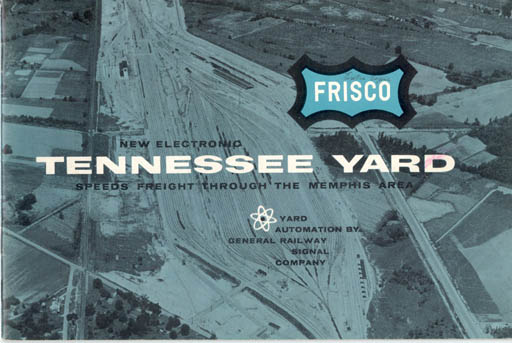
In 1953 President Clark Hungerford asked Chief Engineer E. L. Anderson to initiate a study concerning an electronic hump yard in Memphis to replace Yale Yard. A 333 acre site was chosen in Capleville in south eastern Memphis. In making the choice, Yard Yard was considered not large enough for the new facility and the Harvard Yard near Marion, AR was considered an operational problem. The January, 1954 cost estimate was $9.5 million, with a fianl construction cost nearly $10 million. The plan was approved by Memphis and Shelby county in July, 1954. The Board of Directors appropriated the funds for construction on June 3, 1955. From January to March, 1955 a scale model of the entire yard was constructed by Frisco engineers. |





|
Tennessee Yard is a "pullback" yard, one with parallel rather than end-to-end receiving and departure yards. Cars arriving southbound are pulled over the crest of the hump. The engines then reverse direction to push the cars over the crest of the hump into the retarder yard. TY is also unique in that northbound arriving and southbound departing trains travel on tracks that parallel the track where cars are humped as they pass over the crest. Northbound cars that are humped pass over the crest three times, in the train arriving, in the cut pulling back to then be pushed over the crest and classified. The bowl of the classification yard had 50 tracks, five groups of 10 tracks, with a total capacity of 2140 cars. The receiving and departure yard is composed of eight tracks, with a total capacity of 1280 cars. The yard was equipped with an icing facility and a stock feeding and resting facility. There was also a cafe and hotel for crews just to the west of the crest tower. TY opened on June 24, 1957.1. The hump conductor was located on the fifth floor of the crest tower. He used the hump list to oversee the operations of the hump. Cars would be cut loose at the crest of the hump and begin their roll down the 4.89% grade. The 198 foot master retarder and five 99 foot group retarders were controlled by the analof "electronic brain. The cars were weighed as they rolled down the hump. Radar checked their speed. The weight, speed, weather, and other factors were used by the computer to calculate the "rollability" of each car. That data was then fed to retarders to control the speed of the car so that it would roll to the far end of the bowl on the assigned track and make a gentle coupling with whatever cars were previously there. At the base of the hump was the five story retarder tower. An operator on the top floor was responsible for overseeing the operation of the retarders and electric switches. He could, at the touch of a lever, adjust the retarding action or change the switches. With the use of the "electronic brain", this was rarely done. The yard was equipped with a car repair shop with three tracks inside and two track outside the building. The engine service facility consisted of four service tracks and one track inside the shop for minor repairs.2. |
 |
Contributed by Kevin Ferguson |
 |
Contributed by Kevin Ferguson |
The page features the brochure that Frisco published in October 1957 to showcase their new yard. The scanning of this brochure was done by Frank Greene.
Some of the pages in the brochure are double pages that are available as larger images here:
Plan
The Classification Job
Retarder Tower
 |
Contributed by Kevin Ferguson |
This aerial view was taken in the mid-1970s. |
 |
Louis A. Marre Photo, Mike Condren Collection |
SLSF SW9 #313 and S-2 #292B is pushing a string of cars over the hump as F7A #5022 leads a train along side. |
 |
David Johnston Photo |
Frisco QLA northbound leaving Tennessee Yard, 7/75. |
 |
Mike Condren Photo |
A pair of SW1500s working the bowl.. |
 |
David Johnston Photo |
A northbound SCL run through train enters Tennesse Yard over the hump. |
 |
David Johnston Photo |
SCL and SLSF power prepare to leave Tennessee Yard southbound, 11/73. |
 |
David Johnston Photo |
SLSF & SCL power on a northbound train entering Tennessee Yard over the hump. |
 |
David Johnston Photo |
The view from the crest tower, 9/73. |
 |
David Johnston Photo |
A pair of SW1500s working the hump, 9/73. |
 |
| Photo by Mike Condren |
| This is a view of the bowl of the yard taken from the crest tower on September 1, 1980 during a tour of the yard for members of the Frisco Modelers Information Group. |
 Under Construction! What your step!
Under Construction! What your step!